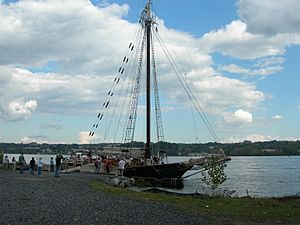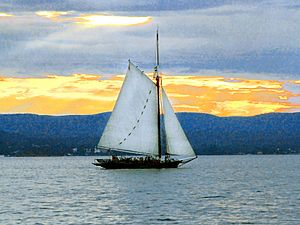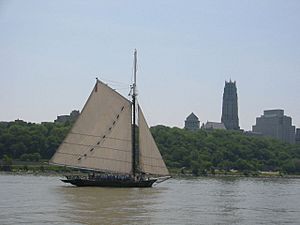Hudson River Sloop Clearwater facts for kids
| Formation | 1966 |
|---|---|
| Founder | Pete Seeger and Toshi Seeger |
| Type | Nonprofit |
| Legal status | 501(c)(3) |
| Headquarters | Beacon, New York |
|
Board President
|
Samantha Hicks |
|
Executive Director
|
David Toman |
| Website | https://www.clearwater.org/ |
The Hudson River Sloop Clearwater, Inc. is a special group based in Beacon, New York. It works to protect the Hudson River and the areas around it. They do this by speaking up for the river and teaching people about it. The organization was started in 1966 by folk singer Pete Seeger and his wife Toshi Seeger. It is famous for its sailing ship, the sloop Clearwater, and for its yearly music and environmental festival, the Great Hudson River Revival.
Contents
A Look Back: Clearwater's History
In 1966, Pete Seeger and his wife Toshi Seeger started the Clearwater organization. Within three years, they had the sloop Clearwater built. Their goal was to help clean up the Hudson River. This idea came about partly because many people were against a plan to build a power plant at Storm King Mountain.
In 1969, the Clearwater sailed for the first time. It traveled down the Atlantic Coast from Maine to South Street Seaport in New York City. A folk musician named Tom Winslow even wrote a song about the sloop called "Hey Looka Yonder (It's the Clearwater)". The song talks about how people from all backgrounds worked together to raise money for the ship. For many years, Clearwater's office was in Poughkeepsie, New York. In 2009, it moved to Beacon, New York.
Protecting Our Environment
Cleaning Up the Hudson River
Clearwater and the Clearwater Festival have worked hard to show how much the Hudson River was polluted. The river had problems like mercury and sewage. But the biggest issue was Polychlorinated biphenyls (PCBs) from General Electric. This company put PCBs into the river between 1947 and 1977. These chemicals caused harm to animals and people who ate fish from the river. Because of Pete Seeger and Clearwater's efforts, parts of the river were named superfund sites. This means they are very polluted places that need a big clean-up.
Clearwater's Achievements
Clearwater became well-known in the 1970s for pushing for the clean-up of PCBs. These chemicals came from factories like General Electric along the river. Clearwater also cares about other issues in the Hudson Valley. These include new buildings, pesticide runoff, and the Indian Point nuclear power plants. Clearwater played a big part in the Environmental Protection Agency (EPA) deciding to make polluters remove toxic PCBs. This helped restore one of the most polluted parts of the river.
In 2002, Pete Seeger was called a "Clean Water Hero." This was for his important work in helping pass the Clean Water Act. His dedication through Clearwater helped use this law to stop polluters. The Clean Water Act is now one of the most successful environmental laws in the country. After Seeger passed away in 2014, the EPA said his "incredible work" helped make the Hudson River cleaner.
Learning About the Environment

Clearwater's programs teach people about the Hudson River's special ecosystem. This river mixes fresh water from the Adirondack Mountains with salty ocean tides near New York City.
The sloop Clearwater sails mostly on the Hudson River. It travels between New York City and Albany, New York. The ship is used to teach school groups about river biology and how to protect waterways. It also offers sails for Clearwater members and the public. People can even volunteer on the ship for a week or as an intern for up to two months. They learn about sailing, teaching, and helping to keep the ship in good shape.
Music and Fun Festivals
One of Clearwater's biggest ways to raise money is its yearly music and environmental festival. It is officially called the "Great Hudson River Revival." This festival was America's oldest and largest event of its kind. It happened every June for over thirty years, with up to 15,000 people attending. The festival raised money and awareness for the river and the Earth. The money helped Clearwater's research, education, and efforts to protect the Hudson River. The music at the festival included many styles, from Blues to Folk. The festival was cancelled in 2022.
In 1984, Seeger also started the Walkabout Clearwater Chorus. This is a community choir that sings about environmental and social justice. The chorus carries a 7-foot-tall (2.1 m) model of the Sloop Clearwater to their shows. They perform at festivals and parades in the Hudson Valley and other places. The chorus is featured on Pete Seeger's 2008 album Pete Seeger at 89. They have also performed in Dortmund, Germany, every two years since 2001. The chorus also runs a coffee house with folk music performers. It happens in White Plains, New York, from October to May each year.
The Sloop Clearwater

Sloop Clearwater sailing up the Hudson River
|
|
| History | |
|---|---|
| Name | Clearwater |
| Builder | Harvey Gamage Shipyard, South Bristol, Maine |
| Laid down | October, 1968 |
| Launched | May 17, 1969 |
| General characteristics | |
| Type | Gaff rigged sloop |
| Length | 106 ft (32 m) overall |
| Beam | 25 ft (7.6 m) |
| Draft | 8 ft (2.4 m) |
| Propulsion | sails; auxiliary engine |
| Sail plan | mainsail, main topsail, jib |
| Notes | 4305 sq ft. (387.5 m²) total sail area |
| Location | Beacon, New York |
| Built | 1968 |
| Architect | Hamlin, Cyrus; Gamage, Harvey Shipyard |
| NRHP reference No. | 04000376 |
| Added to NRHP | May 4, 2004 |
The Hudson River Sloop Clearwater, Inc. owns and runs the sloop Clearwater. This ship is the main part of Clearwater's public education programs. The Clearwater acts like a moving classroom, a science lab, a stage, and a place for discussions.
The Clearwater is a 106-foot (32 m) wooden sailing ship. It was designed like Dutch sailing sloops from the 1700s and 1800s. These ships were built to handle the strong tides, shallow waters, and changing winds of the Hudson River. Cy Hamlin designed the Clearwater, and The Harvey Gamage Shipyard in South Bristol, Maine, built it. The ship was launched in 1969.
The sloop is 76 feet (23 m) long on its deck and 25 feet (7.6 m) wide. It can carry up to 70 tons of cargo. The ship has one tall mast and a topmast, which together reach 108 feet (33 m) high. A 65-foot (20 m) long main boom and a 45-foot (14 m) gaff hold a 3,000-square-foot (280 m2) mainsail. A 28-foot (8.5 m) long bowsprit carries a 900-square-foot (84 m2) jib sail. When the wind is light, a 450-square-foot (42 m2) topsail can also be raised.
In 2004, the sloop Clearwater was added to the National Register of Historic Places. This was because of its importance to the environmental movement. The Clearwater has a smaller sister ship, the Sloop Woody Guthrie. This ship is also used to teach people about the river.
Pete Seeger wrote many songs about water and river protection. For example, in 2012, Seeger and Lorre Wyatt released a music video and song called "God's Counting on Me, God's Counting on You." They recorded it on the Clearwater while sailing on the Hudson in 2010. The song was about the Deepwater Horizon Gulf oil spill of 2010.
More to Explore
- Sustainability
- Biodiversity
- Global warming
- Ecology
- Natural environment
- Recycling
- Outdoor Education


